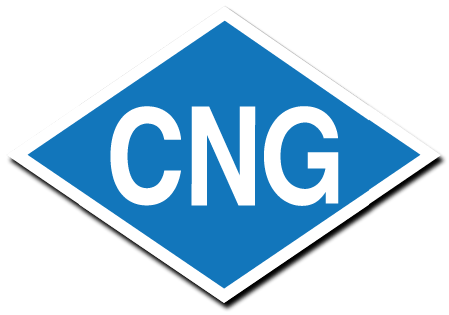About Natural Gas Vehicles (NGV)
A Natural Gas Vehicle is a car, truck, or other vehicle that uses natural gas for fuel. Using natural gas instead of gasoline or diesel is a low-cost, low-emissions solution for reducing our nation’s dependence on foreign energy while also reducing greenhouse gases and urban smog.
With proven reserves of domestic natural gas soaring and our dependence on foreign oil as burdensome as ever, it makes sense to expand the use of clean, inexpensive, and abundant natural gas as a vehicle fuel. Natural gas vehicles (NGVs) are good for our economy and our environment.
Natural gas is cheaper than gasoline per GGE
CNG is an affordable alternative fuel when compared to gasoline or diesel – it can cut fuel costs by about 50% while delivering the same power and performance. Record U.S. natural gas production and storage levels assure reasonable prices for the foreseeable future.

How to Spot
a Natural Gas Vehicle
Most natural gas vehicles sport the Compressed Natural Gas (CNG) diamond shaped logo.
Types of NGVs
Bi-fuel vehicles: run on both gasoline and natural gas. These vehicles can switch seamlessly between the two fuels.
Dual-fuel vehicles: powered by natural gas and diesel fuels. Both fuels are burned together at the same time.
Dedicated vehicles: fueled solely by natural gas.

CNG Flow Structure

NGVs vs. Gasoline / Diesel
NGVs operate on the same basic principles as gasoline-powered vehicles. When the engine in an NGV is started, natural gas flows from the storage cylinders into a fuel line. Near the engine, the natural gas enters a regulator to reduce the pressure. Then the gas feeds through a gaseous fuel-injection system, which introduces the fuel into the cylinders. Sensors and computers adjust the fuel-air mixture so that when a spark plug ignites the gas, it burns efficiently and clean.
Since natural gas is a gas rather than a liquid at standard pressure and temperature, some modifications are required to make an NGV work efficiently. These changes are primarily in the fuel storage tank, fueling receptacle/nozzle and the engine. The specially designed tanks that contain the CNG onboard the vehicle weigh more and take up more space than gasoline or diesel containers.
The Facts
- There are about 142,000 NGVs on U.S. roads today and more than 15.2 million worldwide.
- There are about 1,325 NGV fueling stations in the U.S., and refueling appliances are available for home use.
- In the U.S., about 50 different manufacturers produce 100 models of light-, medium-, and heavy-duty vehicles and engines.
- In the U.S. alone, NGVs offset the use of about 400 million gallons of gasoline in 2013.
- NGVs meet the strictest emission standards, including California’s AT-PZEV standard.
- NGVs are as safe as or safer than traditional gasoline or diesel vehicles.
The Facts
- There are about 142,000 NGVs on U.S. roads today and more than 15.2 million worldwide.
- There are about 1,325 NGV fueling stations in the U.S., and refueling appliances are available for home use.
- In the U.S., about 50 different manufacturers produce 100 models of light-, medium-, and heavy-duty vehicles and engines.
- In the U.S. alone, NGVs offset the use of about 400 million gallons of gasoline in 2013.
- NGVs meet the strictest emission standards, including California’s AT-PZEV standard.
- NGVs are as safe as or safer than traditional gasoline or diesel vehicles.
Frequently Asked Questions
Natural gas vehicles are available in many classes of vehicle. These vehicles are available either from an original equipment manufacturer or from a small volume manufacturer that converts the vehicle to run on natural gas. The vehicles converted by these small volume manufacturers must meet all government safety and emissions requirements. These vehicles range from sedans to heavy duty buses, refuse trucks, and 18-wheelers.
There are two types of fueling equipment for CNG vehicles – fast-fill and time-fill.
In fast-fill, the combination of a compressor(s) coupled with a high-pressure storage tank system, called a cascade, fills the tank in about the same amount of time it takes to fuel an average gasoline vehicle.
A time-fill system does not have a storage system and typically has a smaller and less expensive compressor used to refuel CNG vehicles over longer periods of time. Time fill works well for vehicles that remain idle overnight, such as refuse trucks and school buses.
Most NGVs operate on compressed natural gas. CNG is stored onboard vehicles under high-pressure (3,000-3,600 pounds per square inch) in tube-shaped cylinders that are attached to the rear, top, or undercarriage of the vehicle.
Longer haul applications used in over the road type vehicles use Liquefied Natural Gas or LNG because more fuel can be stored in liquid form than in the compressed natural gas state.
All fuel storage devices meet very rigorous safety standards. They are made of high-strength materials designed to withstand impact, puncture and, in the case of fire, their pressure relief devices (PRDs) provide a controlled venting of the gas rather than letting the pressure build up in the tank.
It depends on the specific vehicle and the choice of the manufacturer. Bi-fuel vehicles require additional storage to accommodate both fuels.
It is very similar to the way you fuel any car or truck. The dispenser looks about the same, but the nozzle is different. Drivers can be easily educated on how to fill a CNG vehicle. Because natural gas is under pressure, the storage systems must be designed so that no fuel escapes when the vehicle is being fueled. Natural gas nozzles lock onto the receptacles and form a leak-free seal, similar to the coupling on an air compressor nozzle. The receptacles are designed so that when the nozzle is removed the gas is prevented from escaping.

Yes, absolutely. Compressed natural gas is stored on board vehicles in tanks that meet the most stringent safety standards in the world. Some of the tests that these tanks must pass are the drop test, the bonfire test, and the gunshot test.
Safety
CNG vs. Gas & Diesel
Unlike other fuels such as diesel, petrol, or LPG, which are heavier than air and will pool on the ground, creating a fire hazard and potential pollution to waterways, CNG is lighter than air. If a CNG leak were to occur, the gas would disperse rapidly upwards into the atmosphere and dissipate.
CNG is very safe. The tanks go through many rigorous safety tests that ensure its sturdiness and safety. Take these factors into account:

Natural gas is odorless.
A distinctive odorant that smells very much like strong sulfur is added prior to distribution. This strong odor makes the presence of a leak very easy to detect.
Natural gas is lighter than air.
If a leak were to develop, the gas would rise and disperse through the atmosphere, giving little chance for ignition. Compare that to gasoline and diesel – both of which are dense liquids that tend to pool and easily ignite.

Natural gas is non-toxic.
When it is inhaled, that are no poisonous ingredients that can be absorbed into the blood.
YCNGA’s
Public CNG Station
Current Price: $1.80 / GGE
Payment Options: Visa, MasterCard, Discover, American Express, Voyager, WEX, and FuelMan
Hours: 24 hours daily
PSI: 3,600
Date Opened: October 6, 2011
Want to find another alternative fuel station? Check out this locator by AFDC Energy.
YCNGA’s
Public CNG Station
Current Price: $1.80 / GGE
Payment Options: Visa, MasterCard, Discover, American Express, Voyager, WEX, and FuelMan
Hours: 24 hours daily
PSI: 3,600
Date Opened: October 6, 2011
Want to find another alternative fuel station? Check out this locator by AFDC Energy.

